Drug Administration and Intravenous Therapy Assignment - Semester 1
VerifiedAdded on 2022/10/06
|23
|4408
|19
Homework Assignment
AI Summary
This assignment delves into the core principles of drug administration and intravenous therapy within a nursing context, referencing the Nurses and Midwifery Board of Australia (NMBA) guidelines. It explores the application of codes of conduct, codes of ethics, and standards of practice, providing detailed explanations on how to comply with each. The assignment covers various aspects of drug handling, including compliance with the Dangerous Drug Act, storage, and documentation of drugs of addiction, as well as the administration of intravenous (IV), intramuscular (IM), and subcutaneous (S/C) medications. It also discusses the legal and ethical considerations surrounding drug prescription, supply, and disposal, along with the rights of medication administration. Furthermore, the assignment examines key pharmacological concepts such as pharmacodynamics, pharmacokinetics, pharmacotherapeutics, toxicology, and adverse reactions, including specific examples like anaphylactic reactions, contraindications, and side effects. Finally, it addresses practical scenarios like dosage calculations, electrolyte solutions, and the appropriate responses to medication errors, including reporting procedures. The assignment emphasizes the importance of safe and competent nursing practice, patient safety, and adherence to established protocols and guidelines.
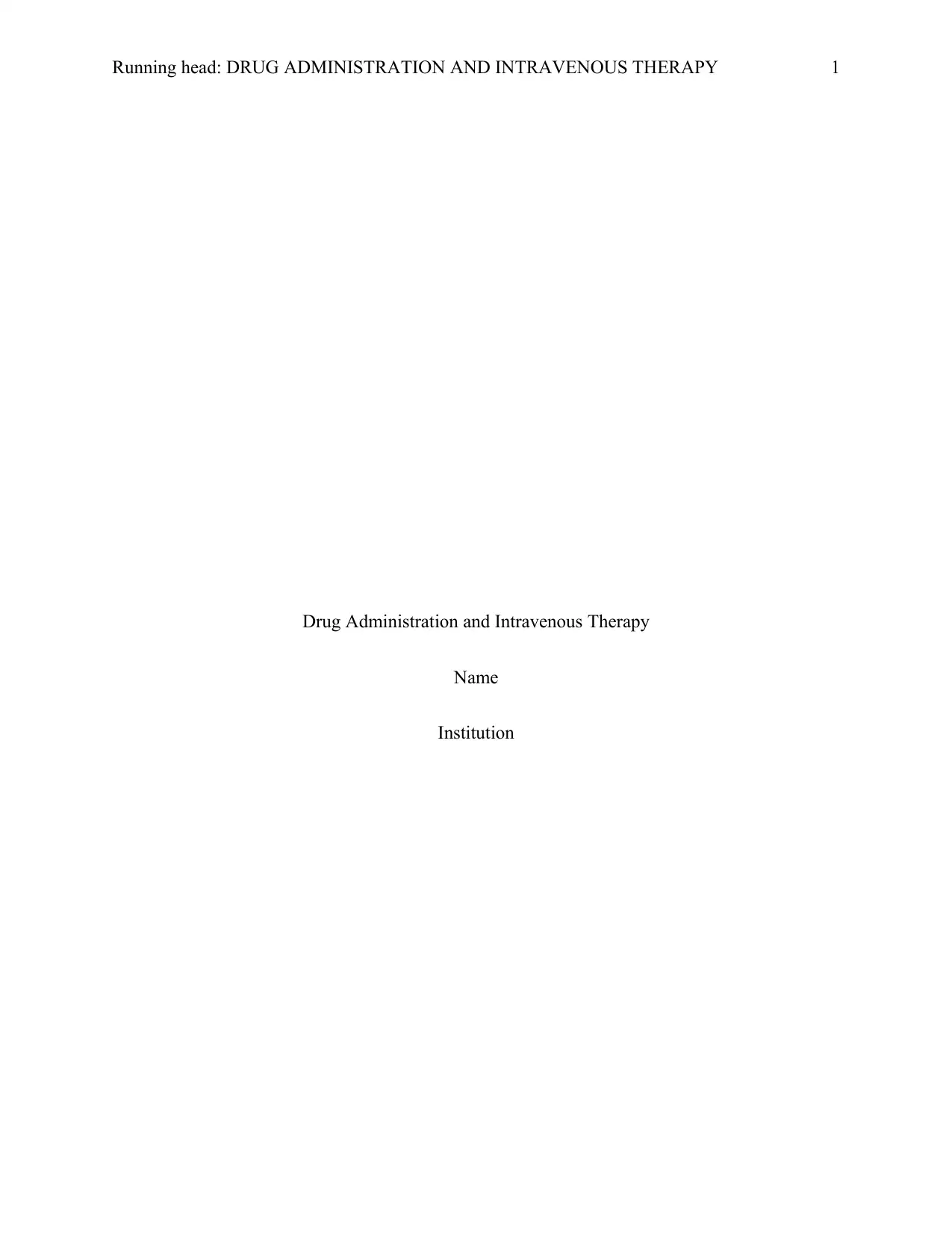
Running head: DRUG ADMINISTRATION AND INTRAVENOUS THERAPY 1
Drug Administration and Intravenous Therapy
Name
Institution
Drug Administration and Intravenous Therapy
Name
Institution
Paraphrase This Document
Need a fresh take? Get an instant paraphrase of this document with our AI Paraphraser
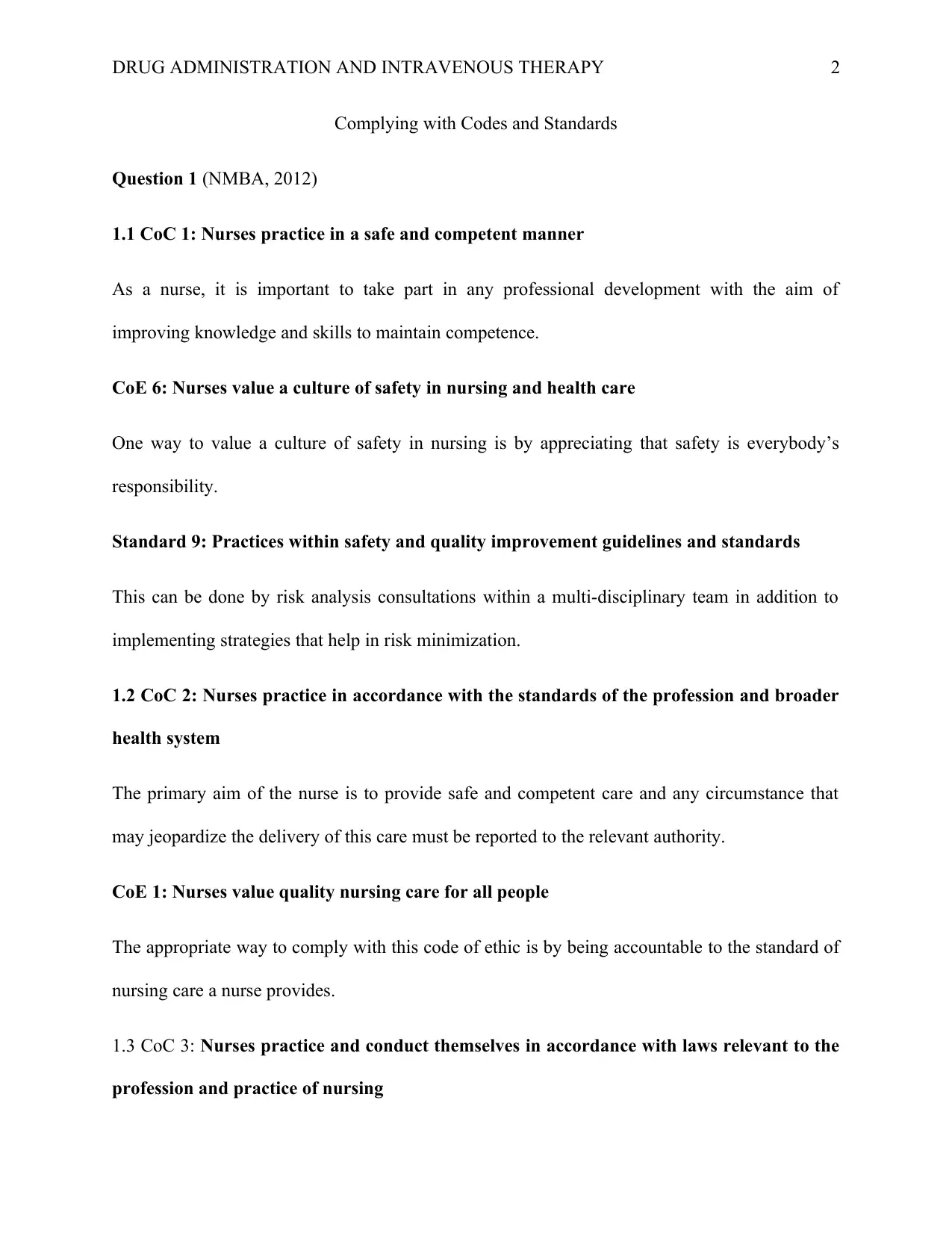
DRUG ADMINISTRATION AND INTRAVENOUS THERAPY 2
Complying with Codes and Standards
Question 1 (NMBA, 2012)
1.1 CoC 1: Nurses practice in a safe and competent manner
As a nurse, it is important to take part in any professional development with the aim of
improving knowledge and skills to maintain competence.
CoE 6: Nurses value a culture of safety in nursing and health care
One way to value a culture of safety in nursing is by appreciating that safety is everybody’s
responsibility.
Standard 9: Practices within safety and quality improvement guidelines and standards
This can be done by risk analysis consultations within a multi-disciplinary team in addition to
implementing strategies that help in risk minimization.
1.2 CoC 2: Nurses practice in accordance with the standards of the profession and broader
health system
The primary aim of the nurse is to provide safe and competent care and any circumstance that
may jeopardize the delivery of this care must be reported to the relevant authority.
CoE 1: Nurses value quality nursing care for all people
The appropriate way to comply with this code of ethic is by being accountable to the standard of
nursing care a nurse provides.
1.3 CoC 3: Nurses practice and conduct themselves in accordance with laws relevant to the
profession and practice of nursing
Complying with Codes and Standards
Question 1 (NMBA, 2012)
1.1 CoC 1: Nurses practice in a safe and competent manner
As a nurse, it is important to take part in any professional development with the aim of
improving knowledge and skills to maintain competence.
CoE 6: Nurses value a culture of safety in nursing and health care
One way to value a culture of safety in nursing is by appreciating that safety is everybody’s
responsibility.
Standard 9: Practices within safety and quality improvement guidelines and standards
This can be done by risk analysis consultations within a multi-disciplinary team in addition to
implementing strategies that help in risk minimization.
1.2 CoC 2: Nurses practice in accordance with the standards of the profession and broader
health system
The primary aim of the nurse is to provide safe and competent care and any circumstance that
may jeopardize the delivery of this care must be reported to the relevant authority.
CoE 1: Nurses value quality nursing care for all people
The appropriate way to comply with this code of ethic is by being accountable to the standard of
nursing care a nurse provides.
1.3 CoC 3: Nurses practice and conduct themselves in accordance with laws relevant to the
profession and practice of nursing
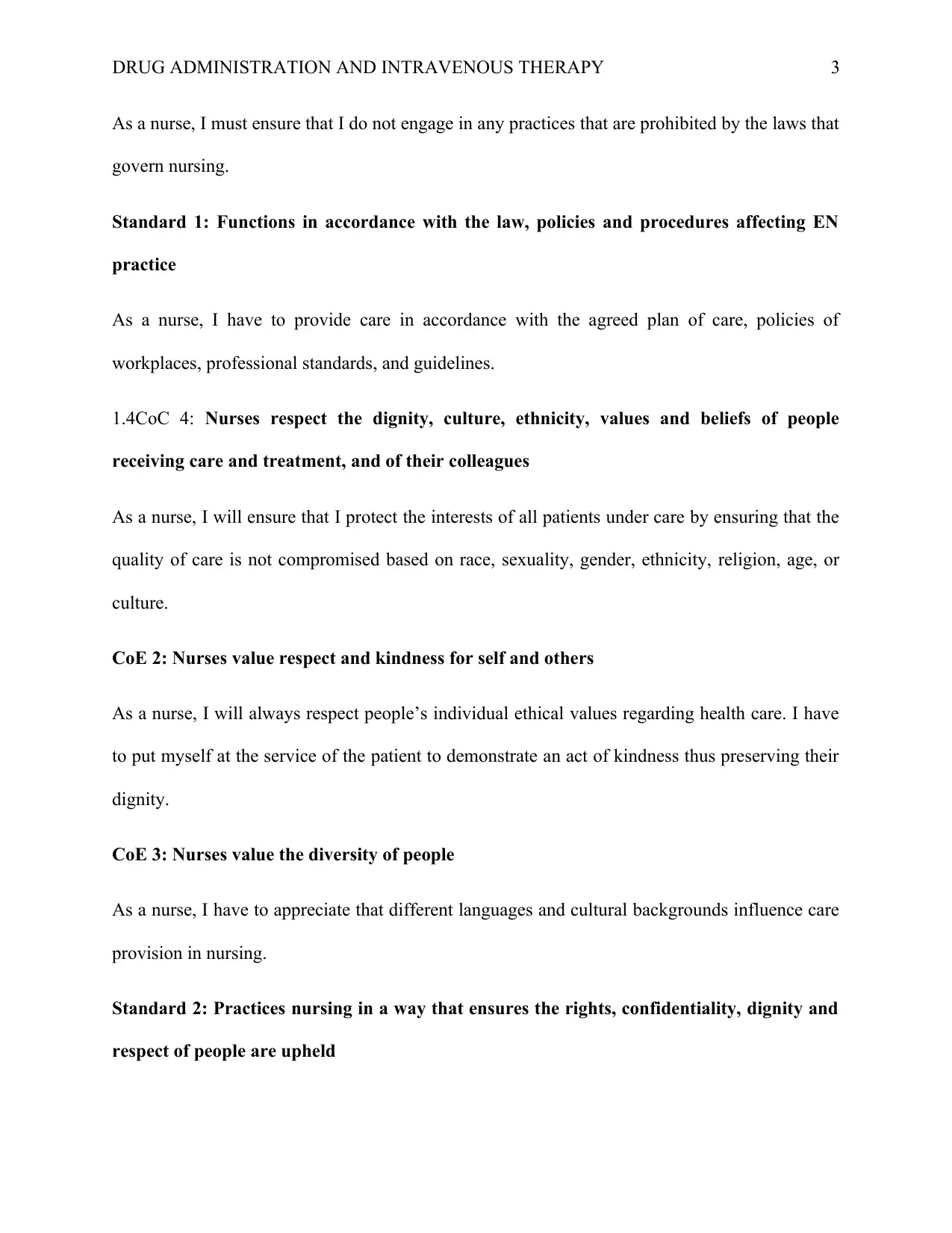
DRUG ADMINISTRATION AND INTRAVENOUS THERAPY 3
As a nurse, I must ensure that I do not engage in any practices that are prohibited by the laws that
govern nursing.
Standard 1: Functions in accordance with the law, policies and procedures affecting EN
practice
As a nurse, I have to provide care in accordance with the agreed plan of care, policies of
workplaces, professional standards, and guidelines.
1.4CoC 4: Nurses respect the dignity, culture, ethnicity, values and beliefs of people
receiving care and treatment, and of their colleagues
As a nurse, I will ensure that I protect the interests of all patients under care by ensuring that the
quality of care is not compromised based on race, sexuality, gender, ethnicity, religion, age, or
culture.
CoE 2: Nurses value respect and kindness for self and others
As a nurse, I will always respect people’s individual ethical values regarding health care. I have
to put myself at the service of the patient to demonstrate an act of kindness thus preserving their
dignity.
CoE 3: Nurses value the diversity of people
As a nurse, I have to appreciate that different languages and cultural backgrounds influence care
provision in nursing.
Standard 2: Practices nursing in a way that ensures the rights, confidentiality, dignity and
respect of people are upheld
As a nurse, I must ensure that I do not engage in any practices that are prohibited by the laws that
govern nursing.
Standard 1: Functions in accordance with the law, policies and procedures affecting EN
practice
As a nurse, I have to provide care in accordance with the agreed plan of care, policies of
workplaces, professional standards, and guidelines.
1.4CoC 4: Nurses respect the dignity, culture, ethnicity, values and beliefs of people
receiving care and treatment, and of their colleagues
As a nurse, I will ensure that I protect the interests of all patients under care by ensuring that the
quality of care is not compromised based on race, sexuality, gender, ethnicity, religion, age, or
culture.
CoE 2: Nurses value respect and kindness for self and others
As a nurse, I will always respect people’s individual ethical values regarding health care. I have
to put myself at the service of the patient to demonstrate an act of kindness thus preserving their
dignity.
CoE 3: Nurses value the diversity of people
As a nurse, I have to appreciate that different languages and cultural backgrounds influence care
provision in nursing.
Standard 2: Practices nursing in a way that ensures the rights, confidentiality, dignity and
respect of people are upheld
⊘ This is a preview!⊘
Do you want full access?
Subscribe today to unlock all pages.

Trusted by 1+ million students worldwide
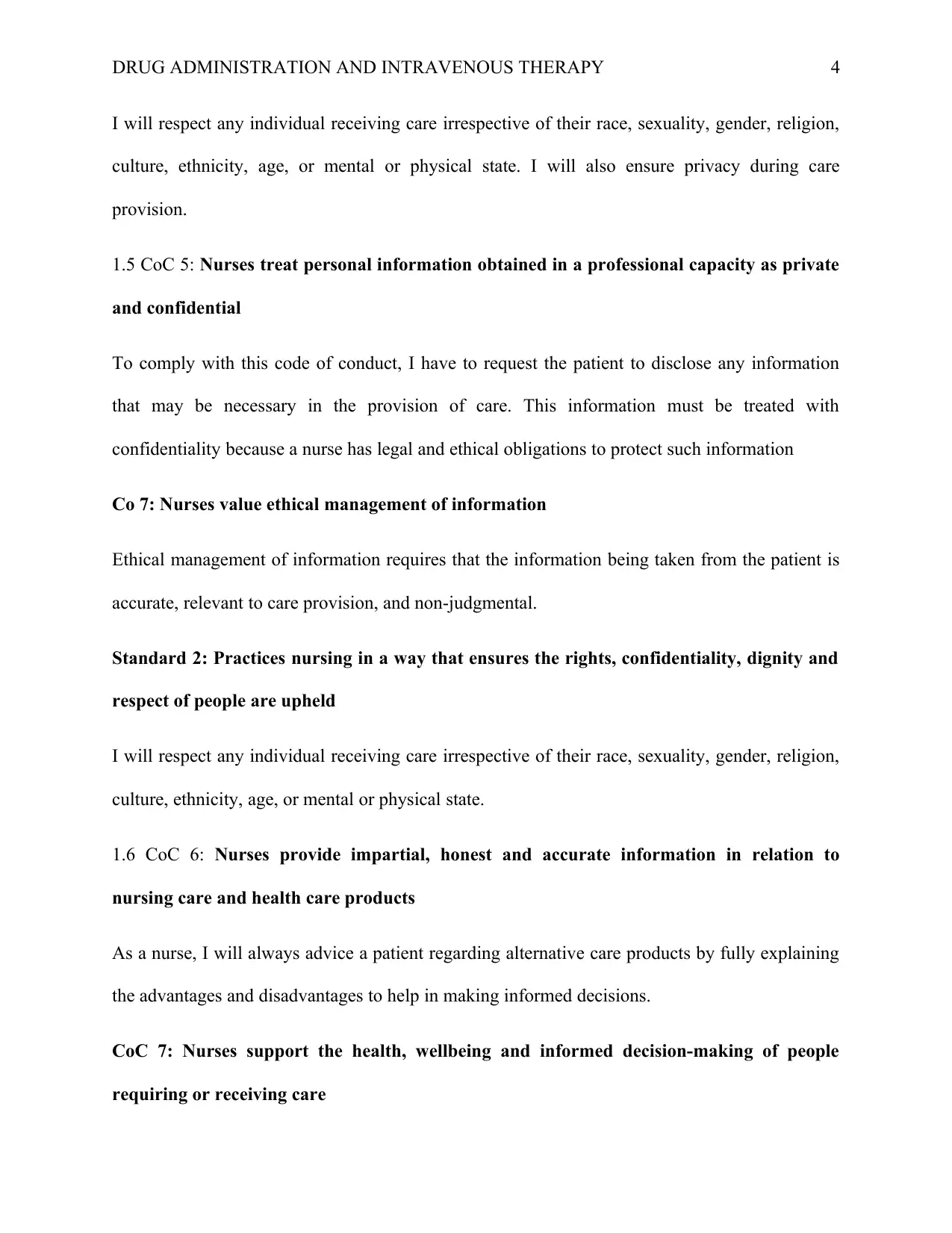
DRUG ADMINISTRATION AND INTRAVENOUS THERAPY 4
I will respect any individual receiving care irrespective of their race, sexuality, gender, religion,
culture, ethnicity, age, or mental or physical state. I will also ensure privacy during care
provision.
1.5 CoC 5: Nurses treat personal information obtained in a professional capacity as private
and confidential
To comply with this code of conduct, I have to request the patient to disclose any information
that may be necessary in the provision of care. This information must be treated with
confidentiality because a nurse has legal and ethical obligations to protect such information
Co 7: Nurses value ethical management of information
Ethical management of information requires that the information being taken from the patient is
accurate, relevant to care provision, and non-judgmental.
Standard 2: Practices nursing in a way that ensures the rights, confidentiality, dignity and
respect of people are upheld
I will respect any individual receiving care irrespective of their race, sexuality, gender, religion,
culture, ethnicity, age, or mental or physical state.
1.6 CoC 6: Nurses provide impartial, honest and accurate information in relation to
nursing care and health care products
As a nurse, I will always advice a patient regarding alternative care products by fully explaining
the advantages and disadvantages to help in making informed decisions.
CoC 7: Nurses support the health, wellbeing and informed decision-making of people
requiring or receiving care
I will respect any individual receiving care irrespective of their race, sexuality, gender, religion,
culture, ethnicity, age, or mental or physical state. I will also ensure privacy during care
provision.
1.5 CoC 5: Nurses treat personal information obtained in a professional capacity as private
and confidential
To comply with this code of conduct, I have to request the patient to disclose any information
that may be necessary in the provision of care. This information must be treated with
confidentiality because a nurse has legal and ethical obligations to protect such information
Co 7: Nurses value ethical management of information
Ethical management of information requires that the information being taken from the patient is
accurate, relevant to care provision, and non-judgmental.
Standard 2: Practices nursing in a way that ensures the rights, confidentiality, dignity and
respect of people are upheld
I will respect any individual receiving care irrespective of their race, sexuality, gender, religion,
culture, ethnicity, age, or mental or physical state.
1.6 CoC 6: Nurses provide impartial, honest and accurate information in relation to
nursing care and health care products
As a nurse, I will always advice a patient regarding alternative care products by fully explaining
the advantages and disadvantages to help in making informed decisions.
CoC 7: Nurses support the health, wellbeing and informed decision-making of people
requiring or receiving care
Paraphrase This Document
Need a fresh take? Get an instant paraphrase of this document with our AI Paraphraser
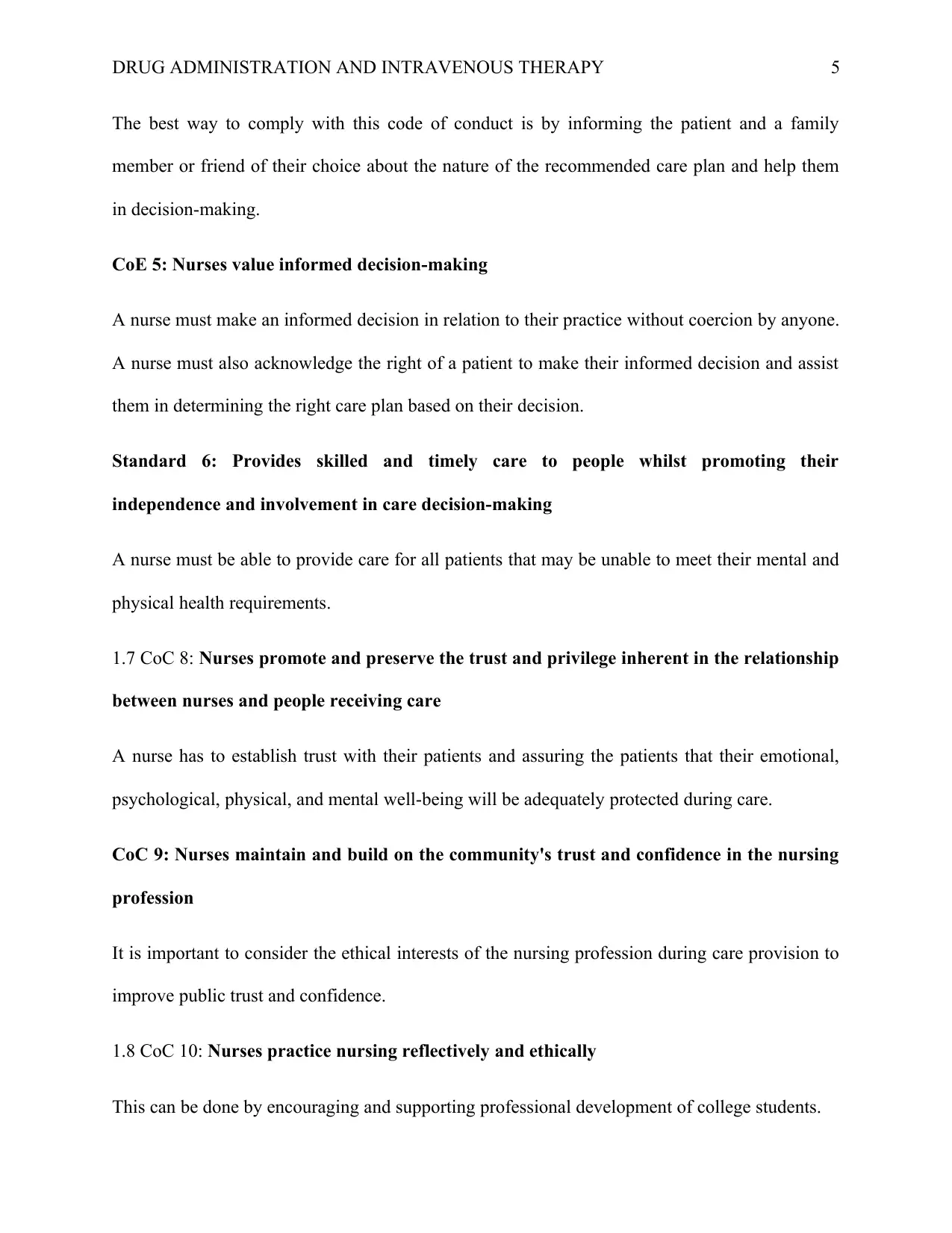
DRUG ADMINISTRATION AND INTRAVENOUS THERAPY 5
The best way to comply with this code of conduct is by informing the patient and a family
member or friend of their choice about the nature of the recommended care plan and help them
in decision-making.
CoE 5: Nurses value informed decision-making
A nurse must make an informed decision in relation to their practice without coercion by anyone.
A nurse must also acknowledge the right of a patient to make their informed decision and assist
them in determining the right care plan based on their decision.
Standard 6: Provides skilled and timely care to people whilst promoting their
independence and involvement in care decision-making
A nurse must be able to provide care for all patients that may be unable to meet their mental and
physical health requirements.
1.7 CoC 8: Nurses promote and preserve the trust and privilege inherent in the relationship
between nurses and people receiving care
A nurse has to establish trust with their patients and assuring the patients that their emotional,
psychological, physical, and mental well-being will be adequately protected during care.
CoC 9: Nurses maintain and build on the community's trust and confidence in the nursing
profession
It is important to consider the ethical interests of the nursing profession during care provision to
improve public trust and confidence.
1.8 CoC 10: Nurses practice nursing reflectively and ethically
This can be done by encouraging and supporting professional development of college students.
The best way to comply with this code of conduct is by informing the patient and a family
member or friend of their choice about the nature of the recommended care plan and help them
in decision-making.
CoE 5: Nurses value informed decision-making
A nurse must make an informed decision in relation to their practice without coercion by anyone.
A nurse must also acknowledge the right of a patient to make their informed decision and assist
them in determining the right care plan based on their decision.
Standard 6: Provides skilled and timely care to people whilst promoting their
independence and involvement in care decision-making
A nurse must be able to provide care for all patients that may be unable to meet their mental and
physical health requirements.
1.7 CoC 8: Nurses promote and preserve the trust and privilege inherent in the relationship
between nurses and people receiving care
A nurse has to establish trust with their patients and assuring the patients that their emotional,
psychological, physical, and mental well-being will be adequately protected during care.
CoC 9: Nurses maintain and build on the community's trust and confidence in the nursing
profession
It is important to consider the ethical interests of the nursing profession during care provision to
improve public trust and confidence.
1.8 CoC 10: Nurses practice nursing reflectively and ethically
This can be done by encouraging and supporting professional development of college students.
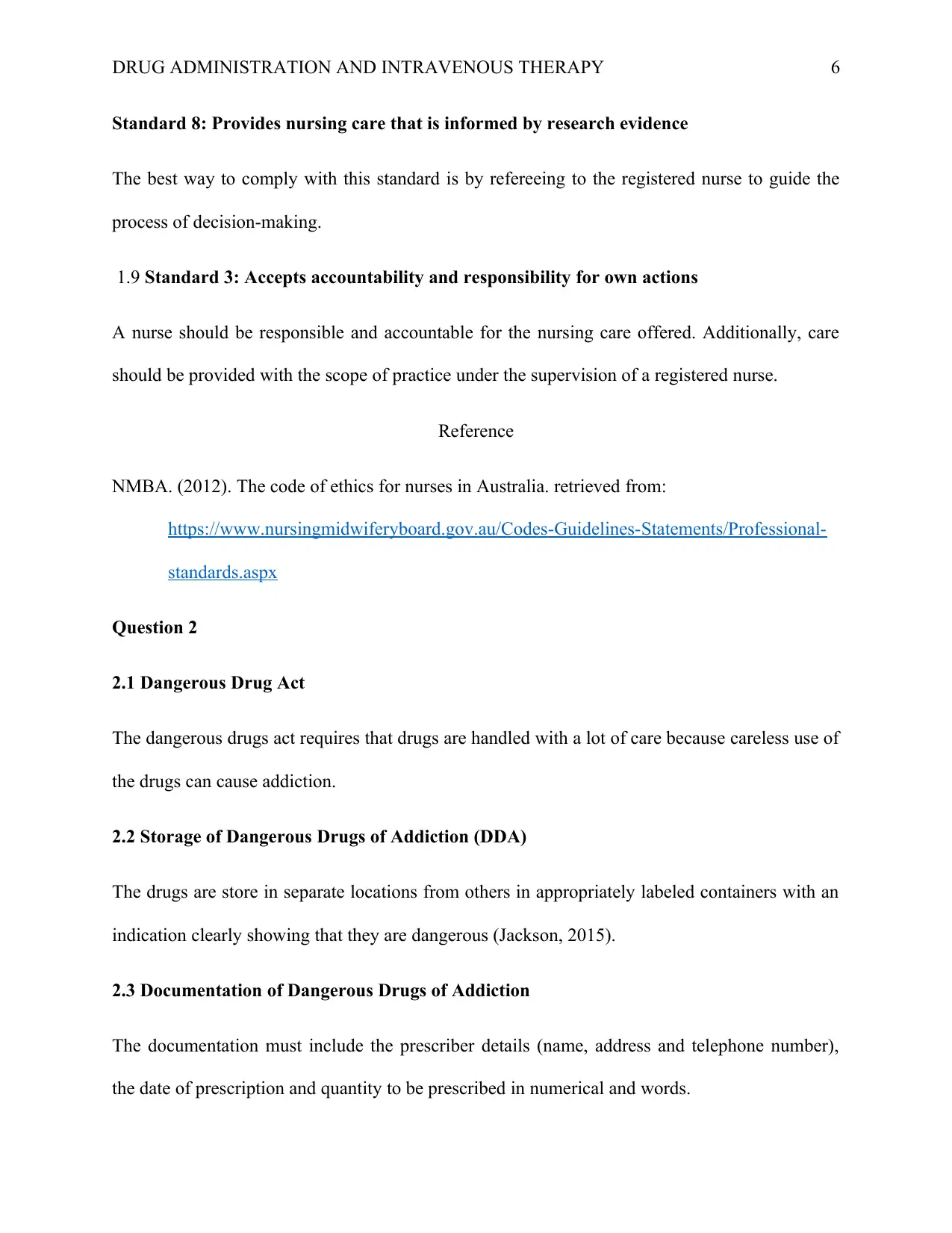
DRUG ADMINISTRATION AND INTRAVENOUS THERAPY 6
Standard 8: Provides nursing care that is informed by research evidence
The best way to comply with this standard is by refereeing to the registered nurse to guide the
process of decision-making.
1.9 Standard 3: Accepts accountability and responsibility for own actions
A nurse should be responsible and accountable for the nursing care offered. Additionally, care
should be provided with the scope of practice under the supervision of a registered nurse.
Reference
NMBA. (2012). The code of ethics for nurses in Australia. retrieved from:
https://www.nursingmidwiferyboard.gov.au/Codes-Guidelines-Statements/Professional-
standards.aspx
Question 2
2.1 Dangerous Drug Act
The dangerous drugs act requires that drugs are handled with a lot of care because careless use of
the drugs can cause addiction.
2.2 Storage of Dangerous Drugs of Addiction (DDA)
The drugs are store in separate locations from others in appropriately labeled containers with an
indication clearly showing that they are dangerous (Jackson, 2015).
2.3 Documentation of Dangerous Drugs of Addiction
The documentation must include the prescriber details (name, address and telephone number),
the date of prescription and quantity to be prescribed in numerical and words.
Standard 8: Provides nursing care that is informed by research evidence
The best way to comply with this standard is by refereeing to the registered nurse to guide the
process of decision-making.
1.9 Standard 3: Accepts accountability and responsibility for own actions
A nurse should be responsible and accountable for the nursing care offered. Additionally, care
should be provided with the scope of practice under the supervision of a registered nurse.
Reference
NMBA. (2012). The code of ethics for nurses in Australia. retrieved from:
https://www.nursingmidwiferyboard.gov.au/Codes-Guidelines-Statements/Professional-
standards.aspx
Question 2
2.1 Dangerous Drug Act
The dangerous drugs act requires that drugs are handled with a lot of care because careless use of
the drugs can cause addiction.
2.2 Storage of Dangerous Drugs of Addiction (DDA)
The drugs are store in separate locations from others in appropriately labeled containers with an
indication clearly showing that they are dangerous (Jackson, 2015).
2.3 Documentation of Dangerous Drugs of Addiction
The documentation must include the prescriber details (name, address and telephone number),
the date of prescription and quantity to be prescribed in numerical and words.
⊘ This is a preview!⊘
Do you want full access?
Subscribe today to unlock all pages.

Trusted by 1+ million students worldwide
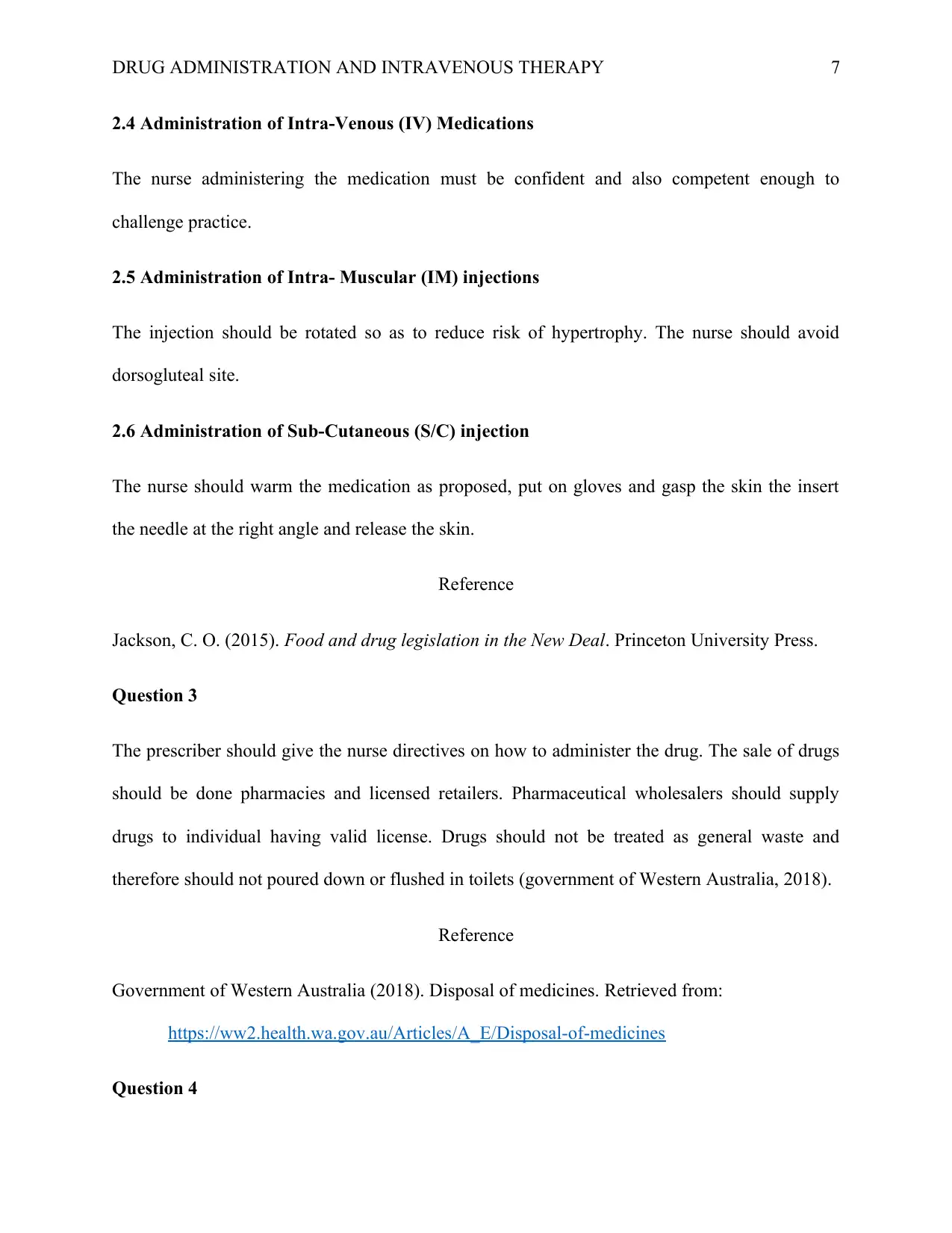
DRUG ADMINISTRATION AND INTRAVENOUS THERAPY 7
2.4 Administration of Intra-Venous (IV) Medications
The nurse administering the medication must be confident and also competent enough to
challenge practice.
2.5 Administration of Intra- Muscular (IM) injections
The injection should be rotated so as to reduce risk of hypertrophy. The nurse should avoid
dorsogluteal site.
2.6 Administration of Sub-Cutaneous (S/C) injection
The nurse should warm the medication as proposed, put on gloves and gasp the skin the insert
the needle at the right angle and release the skin.
Reference
Jackson, C. O. (2015). Food and drug legislation in the New Deal. Princeton University Press.
Question 3
The prescriber should give the nurse directives on how to administer the drug. The sale of drugs
should be done pharmacies and licensed retailers. Pharmaceutical wholesalers should supply
drugs to individual having valid license. Drugs should not be treated as general waste and
therefore should not poured down or flushed in toilets (government of Western Australia, 2018).
Reference
Government of Western Australia (2018). Disposal of medicines. Retrieved from:
https://ww2.health.wa.gov.au/Articles/A_E/Disposal-of-medicines
Question 4
2.4 Administration of Intra-Venous (IV) Medications
The nurse administering the medication must be confident and also competent enough to
challenge practice.
2.5 Administration of Intra- Muscular (IM) injections
The injection should be rotated so as to reduce risk of hypertrophy. The nurse should avoid
dorsogluteal site.
2.6 Administration of Sub-Cutaneous (S/C) injection
The nurse should warm the medication as proposed, put on gloves and gasp the skin the insert
the needle at the right angle and release the skin.
Reference
Jackson, C. O. (2015). Food and drug legislation in the New Deal. Princeton University Press.
Question 3
The prescriber should give the nurse directives on how to administer the drug. The sale of drugs
should be done pharmacies and licensed retailers. Pharmaceutical wholesalers should supply
drugs to individual having valid license. Drugs should not be treated as general waste and
therefore should not poured down or flushed in toilets (government of Western Australia, 2018).
Reference
Government of Western Australia (2018). Disposal of medicines. Retrieved from:
https://ww2.health.wa.gov.au/Articles/A_E/Disposal-of-medicines
Question 4
Paraphrase This Document
Need a fresh take? Get an instant paraphrase of this document with our AI Paraphraser
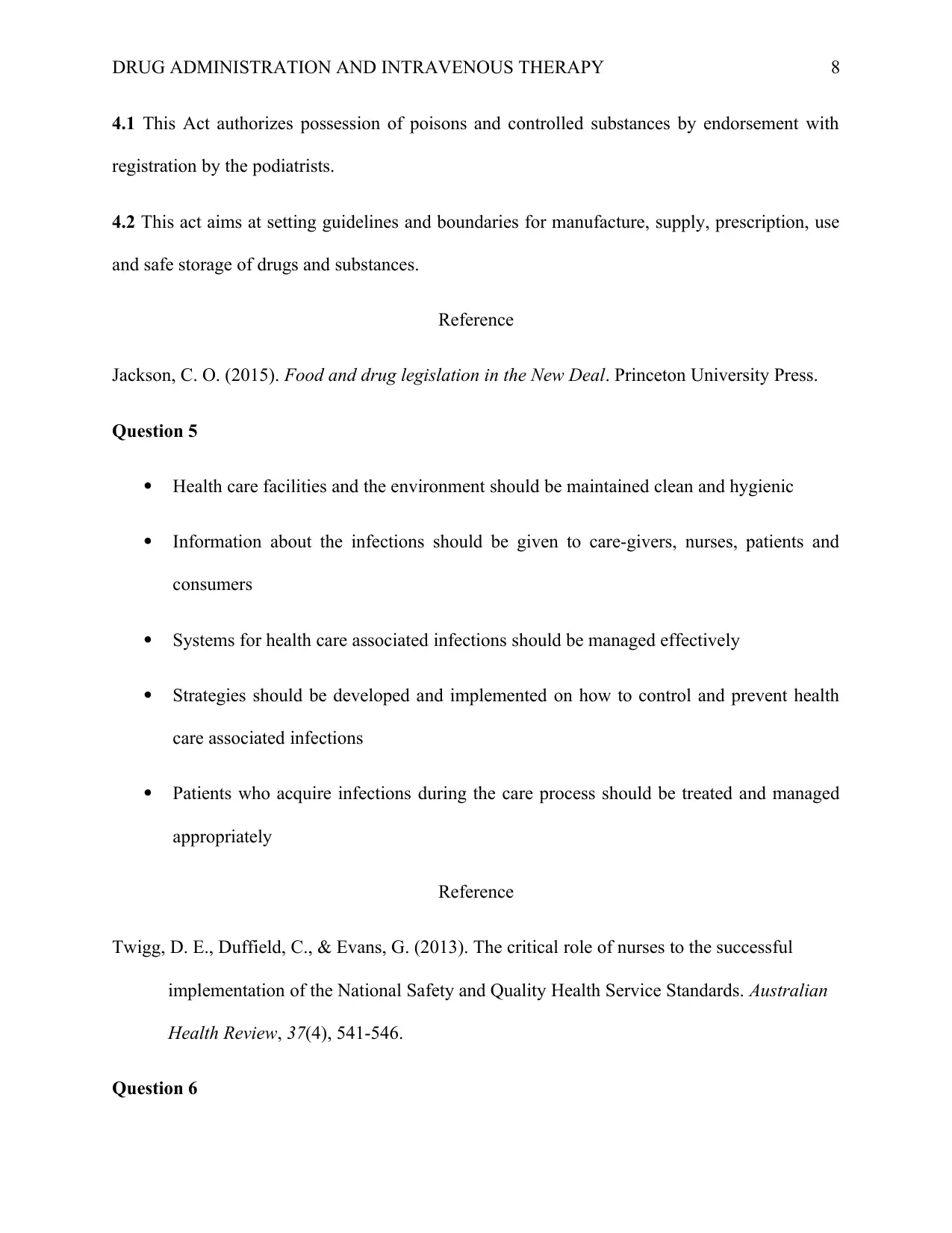
DRUG ADMINISTRATION AND INTRAVENOUS THERAPY 8
4.1 This Act authorizes possession of poisons and controlled substances by endorsement with
registration by the podiatrists.
4.2 This act aims at setting guidelines and boundaries for manufacture, supply, prescription, use
and safe storage of drugs and substances.
Reference
Jackson, C. O. (2015). Food and drug legislation in the New Deal. Princeton University Press.
Question 5
Health care facilities and the environment should be maintained clean and hygienic
Information about the infections should be given to care-givers, nurses, patients and
consumers
Systems for health care associated infections should be managed effectively
Strategies should be developed and implemented on how to control and prevent health
care associated infections
Patients who acquire infections during the care process should be treated and managed
appropriately
Reference
Twigg, D. E., Duffield, C., & Evans, G. (2013). The critical role of nurses to the successful
implementation of the National Safety and Quality Health Service Standards. Australian
Health Review, 37(4), 541-546.
Question 6
4.1 This Act authorizes possession of poisons and controlled substances by endorsement with
registration by the podiatrists.
4.2 This act aims at setting guidelines and boundaries for manufacture, supply, prescription, use
and safe storage of drugs and substances.
Reference
Jackson, C. O. (2015). Food and drug legislation in the New Deal. Princeton University Press.
Question 5
Health care facilities and the environment should be maintained clean and hygienic
Information about the infections should be given to care-givers, nurses, patients and
consumers
Systems for health care associated infections should be managed effectively
Strategies should be developed and implemented on how to control and prevent health
care associated infections
Patients who acquire infections during the care process should be treated and managed
appropriately
Reference
Twigg, D. E., Duffield, C., & Evans, G. (2013). The critical role of nurses to the successful
implementation of the National Safety and Quality Health Service Standards. Australian
Health Review, 37(4), 541-546.
Question 6
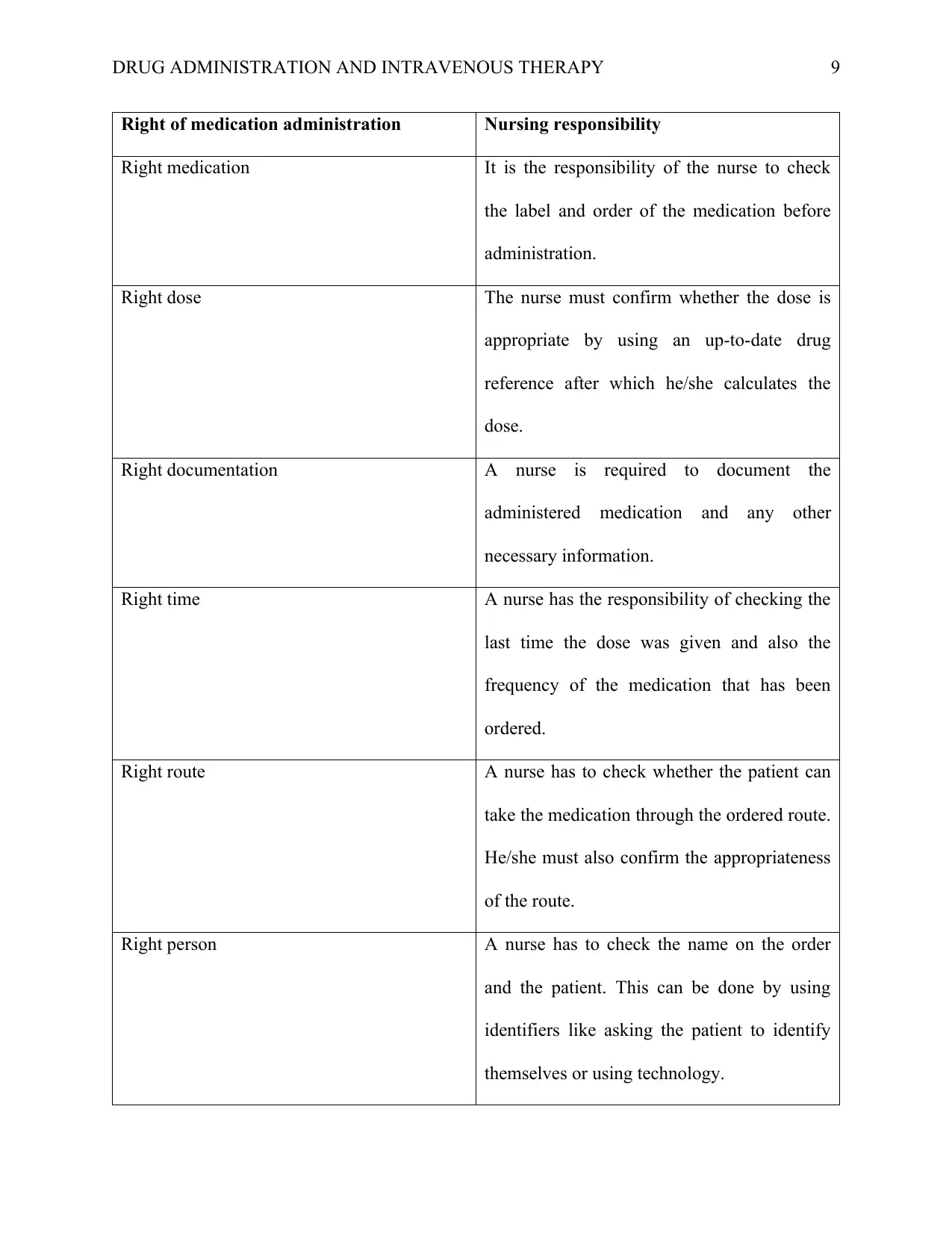
DRUG ADMINISTRATION AND INTRAVENOUS THERAPY 9
Right of medication administration Nursing responsibility
Right medication It is the responsibility of the nurse to check
the label and order of the medication before
administration.
Right dose The nurse must confirm whether the dose is
appropriate by using an up-to-date drug
reference after which he/she calculates the
dose.
Right documentation A nurse is required to document the
administered medication and any other
necessary information.
Right time A nurse has the responsibility of checking the
last time the dose was given and also the
frequency of the medication that has been
ordered.
Right route A nurse has to check whether the patient can
take the medication through the ordered route.
He/she must also confirm the appropriateness
of the route.
Right person A nurse has to check the name on the order
and the patient. This can be done by using
identifiers like asking the patient to identify
themselves or using technology.
Right of medication administration Nursing responsibility
Right medication It is the responsibility of the nurse to check
the label and order of the medication before
administration.
Right dose The nurse must confirm whether the dose is
appropriate by using an up-to-date drug
reference after which he/she calculates the
dose.
Right documentation A nurse is required to document the
administered medication and any other
necessary information.
Right time A nurse has the responsibility of checking the
last time the dose was given and also the
frequency of the medication that has been
ordered.
Right route A nurse has to check whether the patient can
take the medication through the ordered route.
He/she must also confirm the appropriateness
of the route.
Right person A nurse has to check the name on the order
and the patient. This can be done by using
identifiers like asking the patient to identify
themselves or using technology.
⊘ This is a preview!⊘
Do you want full access?
Subscribe today to unlock all pages.

Trusted by 1+ million students worldwide
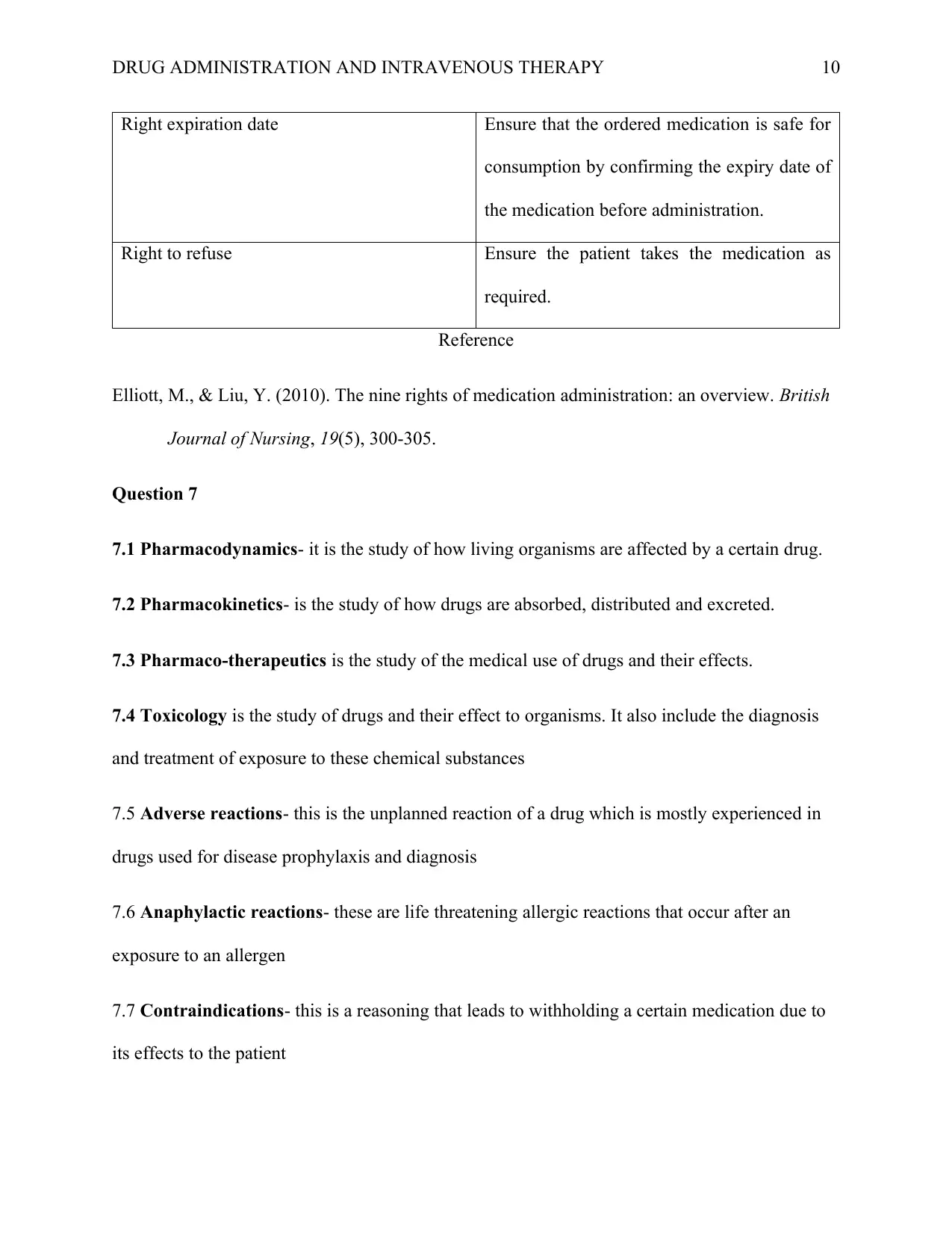
DRUG ADMINISTRATION AND INTRAVENOUS THERAPY 10
Right expiration date Ensure that the ordered medication is safe for
consumption by confirming the expiry date of
the medication before administration.
Right to refuse Ensure the patient takes the medication as
required.
Reference
Elliott, M., & Liu, Y. (2010). The nine rights of medication administration: an overview. British
Journal of Nursing, 19(5), 300-305.
Question 7
7.1 Pharmacodynamics- it is the study of how living organisms are affected by a certain drug.
7.2 Pharmacokinetics- is the study of how drugs are absorbed, distributed and excreted.
7.3 Pharmaco-therapeutics is the study of the medical use of drugs and their effects.
7.4 Toxicology is the study of drugs and their effect to organisms. It also include the diagnosis
and treatment of exposure to these chemical substances
7.5 Adverse reactions- this is the unplanned reaction of a drug which is mostly experienced in
drugs used for disease prophylaxis and diagnosis
7.6 Anaphylactic reactions- these are life threatening allergic reactions that occur after an
exposure to an allergen
7.7 Contraindications- this is a reasoning that leads to withholding a certain medication due to
its effects to the patient
Right expiration date Ensure that the ordered medication is safe for
consumption by confirming the expiry date of
the medication before administration.
Right to refuse Ensure the patient takes the medication as
required.
Reference
Elliott, M., & Liu, Y. (2010). The nine rights of medication administration: an overview. British
Journal of Nursing, 19(5), 300-305.
Question 7
7.1 Pharmacodynamics- it is the study of how living organisms are affected by a certain drug.
7.2 Pharmacokinetics- is the study of how drugs are absorbed, distributed and excreted.
7.3 Pharmaco-therapeutics is the study of the medical use of drugs and their effects.
7.4 Toxicology is the study of drugs and their effect to organisms. It also include the diagnosis
and treatment of exposure to these chemical substances
7.5 Adverse reactions- this is the unplanned reaction of a drug which is mostly experienced in
drugs used for disease prophylaxis and diagnosis
7.6 Anaphylactic reactions- these are life threatening allergic reactions that occur after an
exposure to an allergen
7.7 Contraindications- this is a reasoning that leads to withholding a certain medication due to
its effects to the patient
Paraphrase This Document
Need a fresh take? Get an instant paraphrase of this document with our AI Paraphraser
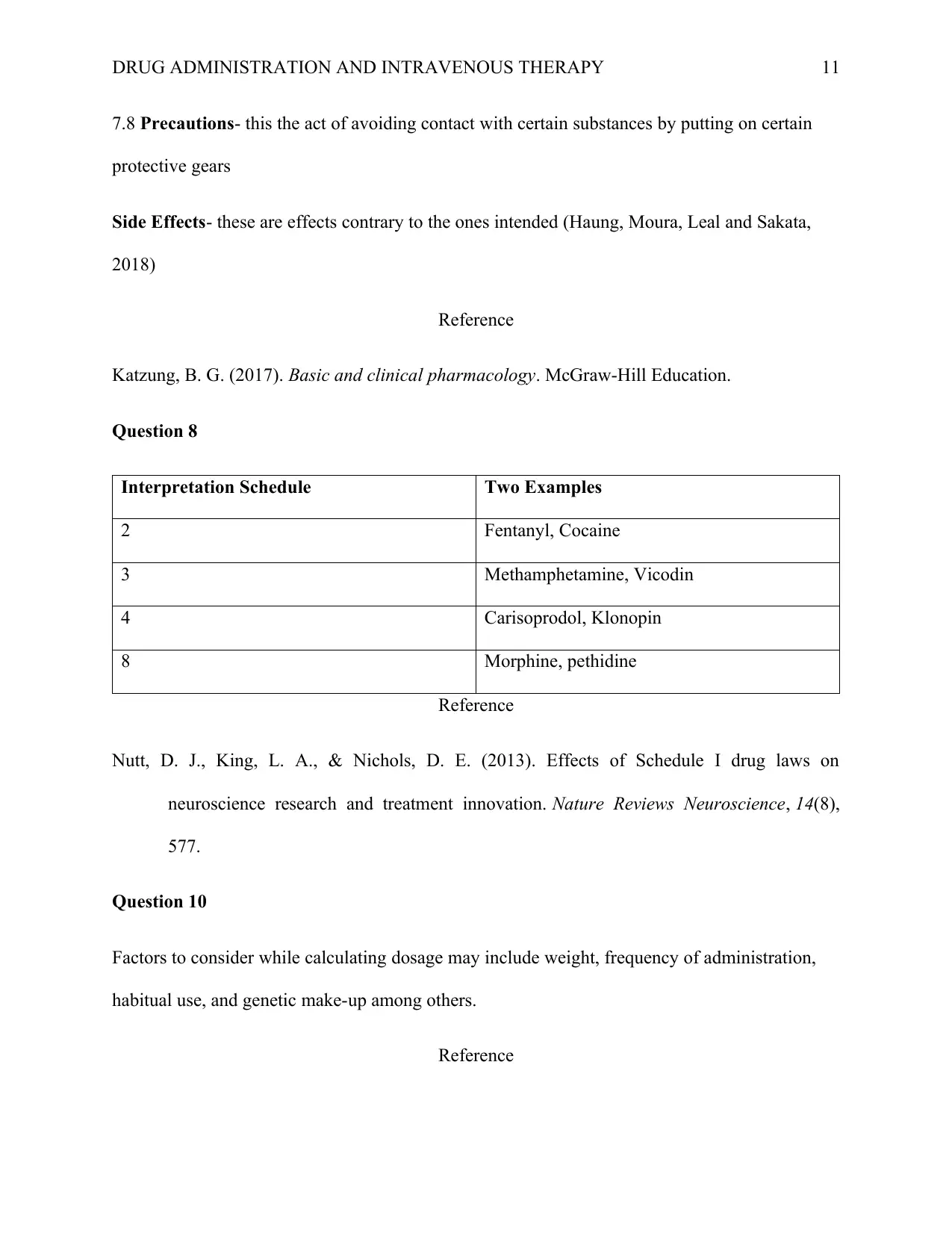
DRUG ADMINISTRATION AND INTRAVENOUS THERAPY 11
7.8 Precautions- this the act of avoiding contact with certain substances by putting on certain
protective gears
Side Effects- these are effects contrary to the ones intended (Haung, Moura, Leal and Sakata,
2018)
Reference
Katzung, B. G. (2017). Basic and clinical pharmacology. McGraw-Hill Education.
Question 8
Interpretation Schedule Two Examples
2 Fentanyl, Cocaine
3 Methamphetamine, Vicodin
4 Carisoprodol, Klonopin
8 Morphine, pethidine
Reference
Nutt, D. J., King, L. A., & Nichols, D. E. (2013). Effects of Schedule I drug laws on
neuroscience research and treatment innovation. Nature Reviews Neuroscience, 14(8),
577.
Question 10
Factors to consider while calculating dosage may include weight, frequency of administration,
habitual use, and genetic make-up among others.
Reference
7.8 Precautions- this the act of avoiding contact with certain substances by putting on certain
protective gears
Side Effects- these are effects contrary to the ones intended (Haung, Moura, Leal and Sakata,
2018)
Reference
Katzung, B. G. (2017). Basic and clinical pharmacology. McGraw-Hill Education.
Question 8
Interpretation Schedule Two Examples
2 Fentanyl, Cocaine
3 Methamphetamine, Vicodin
4 Carisoprodol, Klonopin
8 Morphine, pethidine
Reference
Nutt, D. J., King, L. A., & Nichols, D. E. (2013). Effects of Schedule I drug laws on
neuroscience research and treatment innovation. Nature Reviews Neuroscience, 14(8),
577.
Question 10
Factors to consider while calculating dosage may include weight, frequency of administration,
habitual use, and genetic make-up among others.
Reference
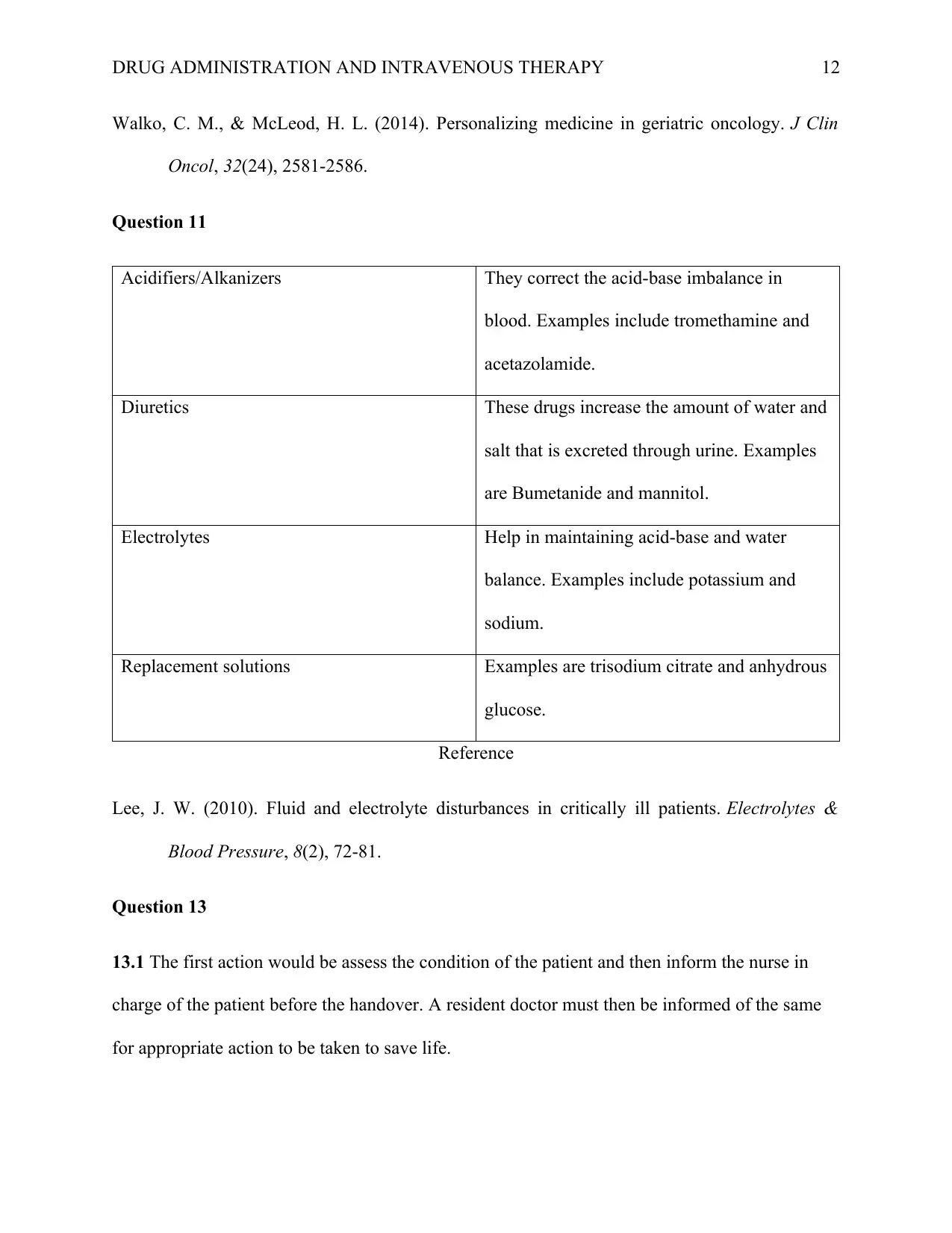
DRUG ADMINISTRATION AND INTRAVENOUS THERAPY 12
Walko, C. M., & McLeod, H. L. (2014). Personalizing medicine in geriatric oncology. J Clin
Oncol, 32(24), 2581-2586.
Question 11
Acidifiers/Alkanizers They correct the acid-base imbalance in
blood. Examples include tromethamine and
acetazolamide.
Diuretics These drugs increase the amount of water and
salt that is excreted through urine. Examples
are Bumetanide and mannitol.
Electrolytes Help in maintaining acid-base and water
balance. Examples include potassium and
sodium.
Replacement solutions Examples are trisodium citrate and anhydrous
glucose.
Reference
Lee, J. W. (2010). Fluid and electrolyte disturbances in critically ill patients. Electrolytes &
Blood Pressure, 8(2), 72-81.
Question 13
13.1 The first action would be assess the condition of the patient and then inform the nurse in
charge of the patient before the handover. A resident doctor must then be informed of the same
for appropriate action to be taken to save life.
Walko, C. M., & McLeod, H. L. (2014). Personalizing medicine in geriatric oncology. J Clin
Oncol, 32(24), 2581-2586.
Question 11
Acidifiers/Alkanizers They correct the acid-base imbalance in
blood. Examples include tromethamine and
acetazolamide.
Diuretics These drugs increase the amount of water and
salt that is excreted through urine. Examples
are Bumetanide and mannitol.
Electrolytes Help in maintaining acid-base and water
balance. Examples include potassium and
sodium.
Replacement solutions Examples are trisodium citrate and anhydrous
glucose.
Reference
Lee, J. W. (2010). Fluid and electrolyte disturbances in critically ill patients. Electrolytes &
Blood Pressure, 8(2), 72-81.
Question 13
13.1 The first action would be assess the condition of the patient and then inform the nurse in
charge of the patient before the handover. A resident doctor must then be informed of the same
for appropriate action to be taken to save life.
⊘ This is a preview!⊘
Do you want full access?
Subscribe today to unlock all pages.

Trusted by 1+ million students worldwide
1 out of 23
Related Documents
Your All-in-One AI-Powered Toolkit for Academic Success.
+13062052269
info@desklib.com
Available 24*7 on WhatsApp / Email
![[object Object]](/_next/static/media/star-bottom.7253800d.svg)
Unlock your academic potential
Copyright © 2020–2025 A2Z Services. All Rights Reserved. Developed and managed by ZUCOL.



